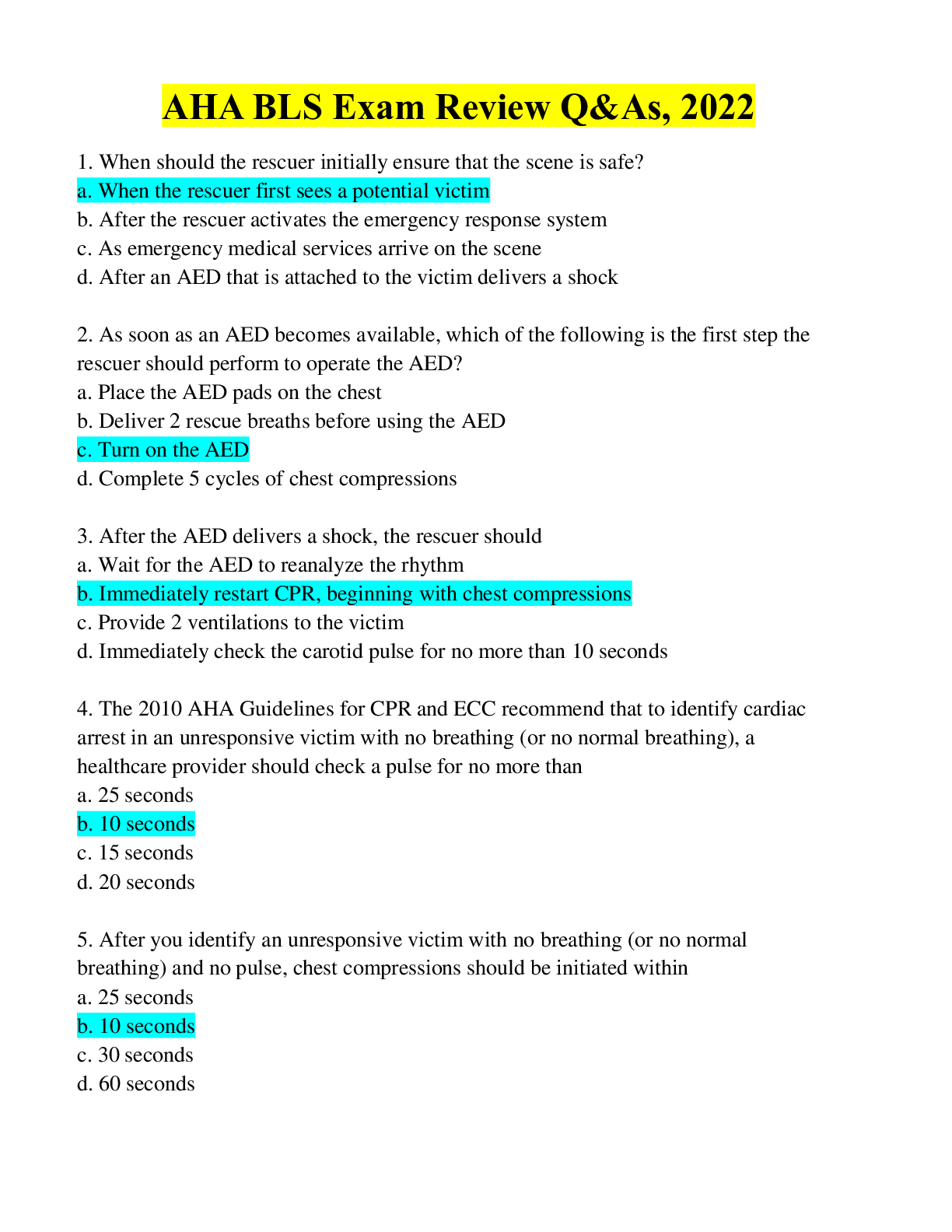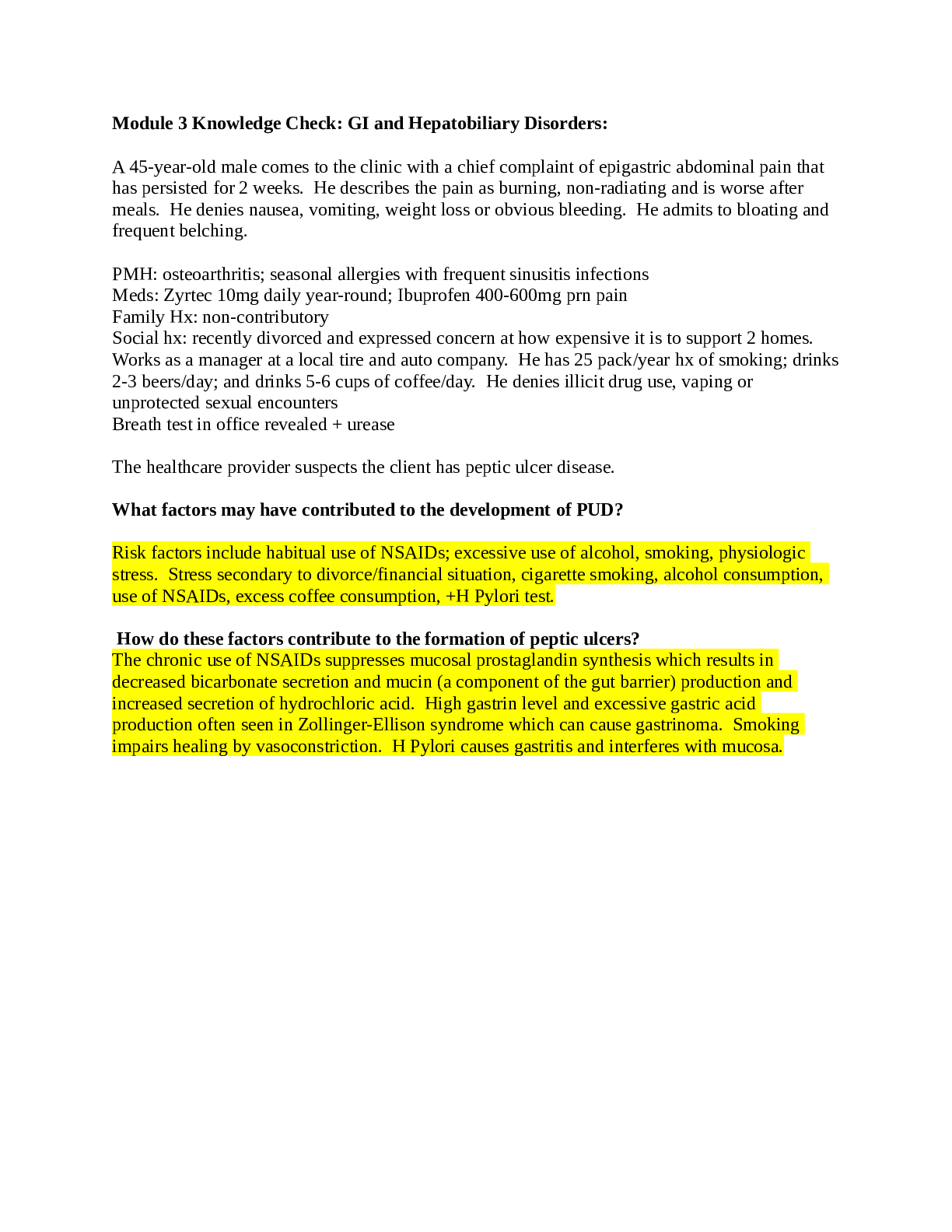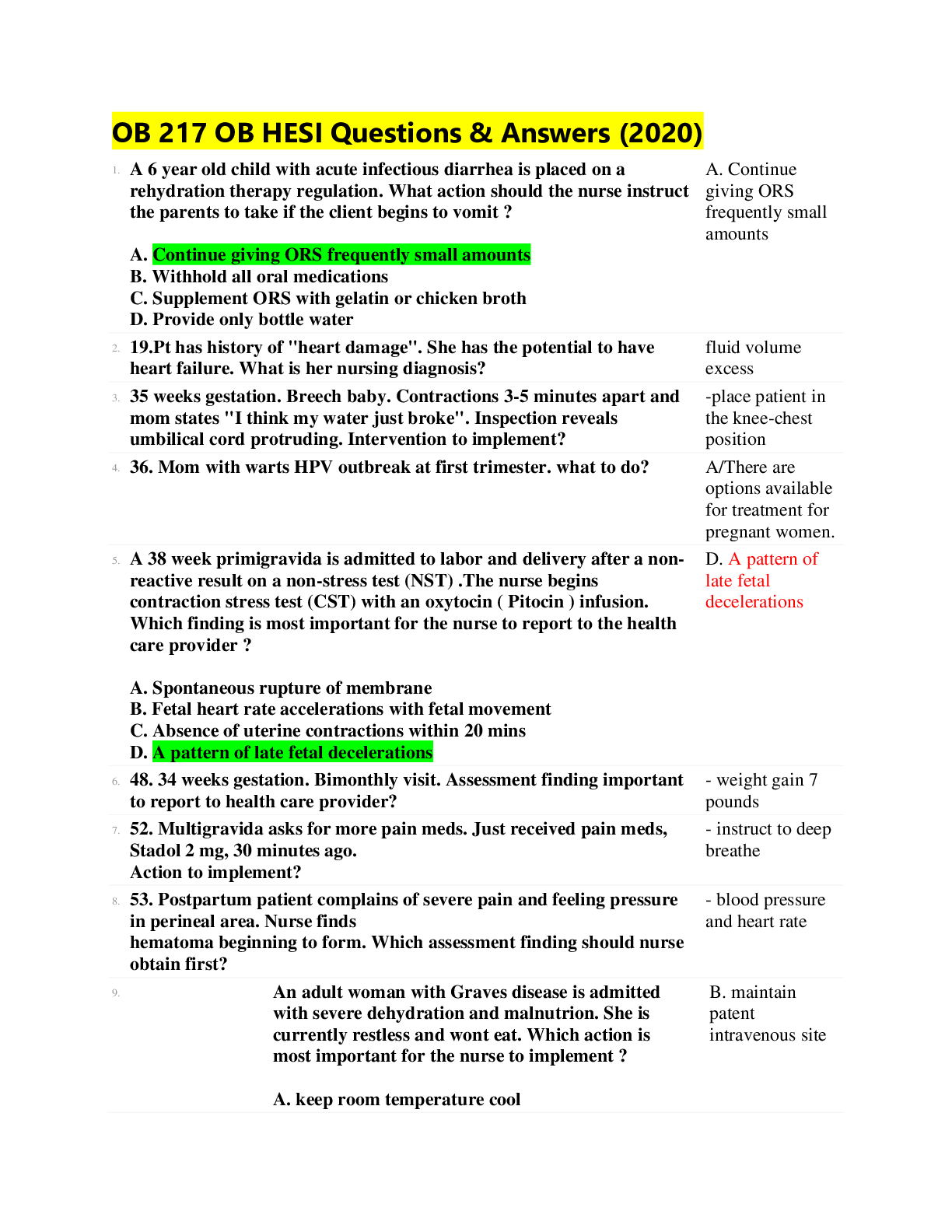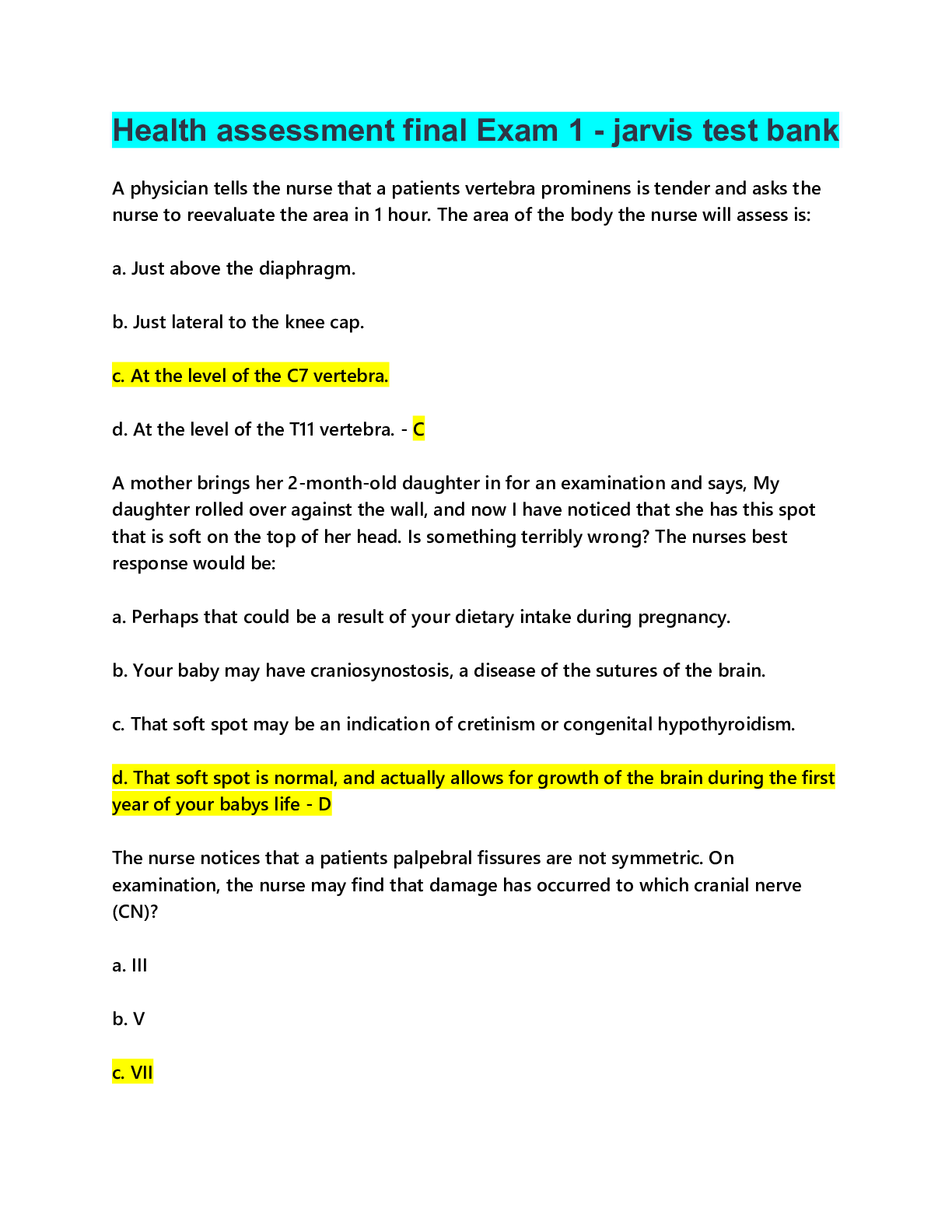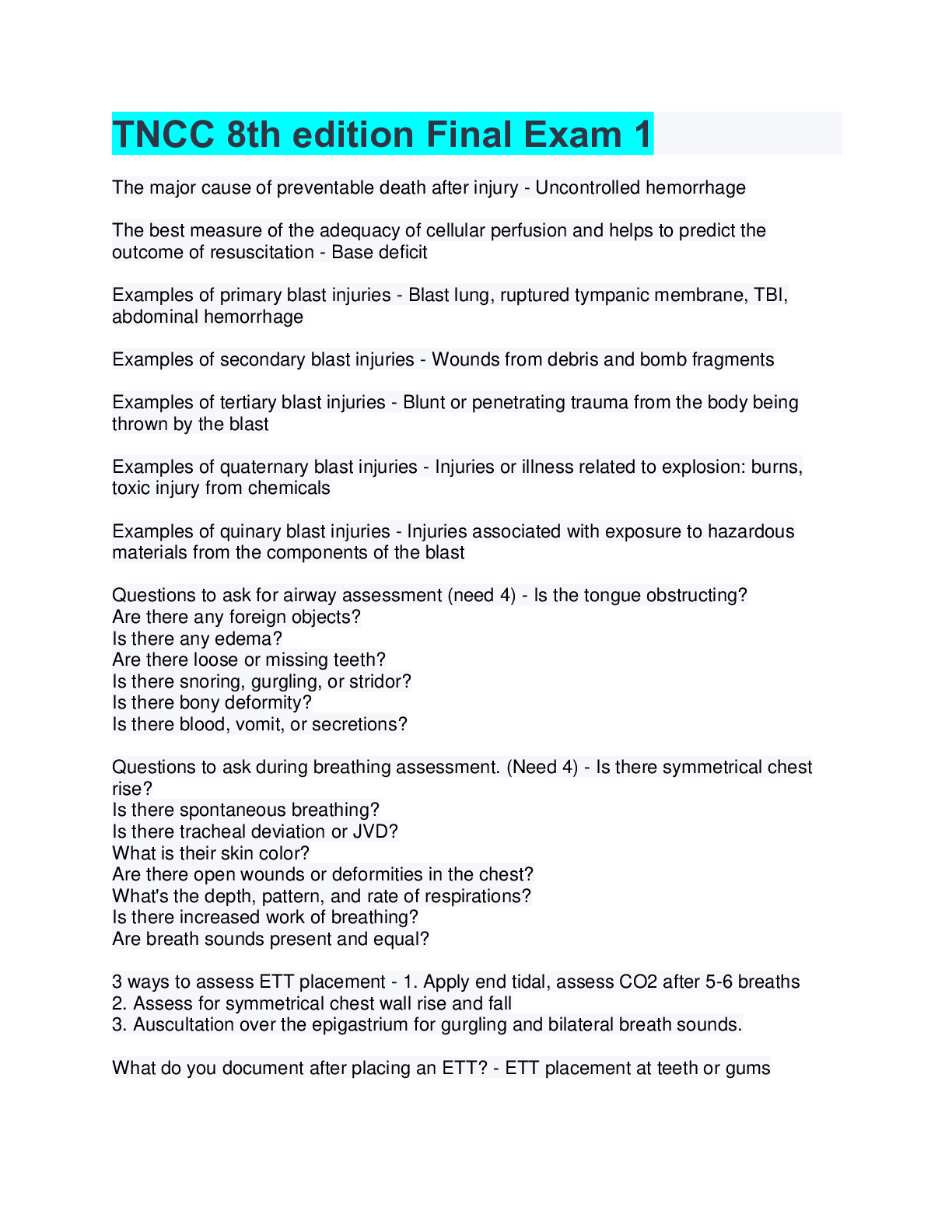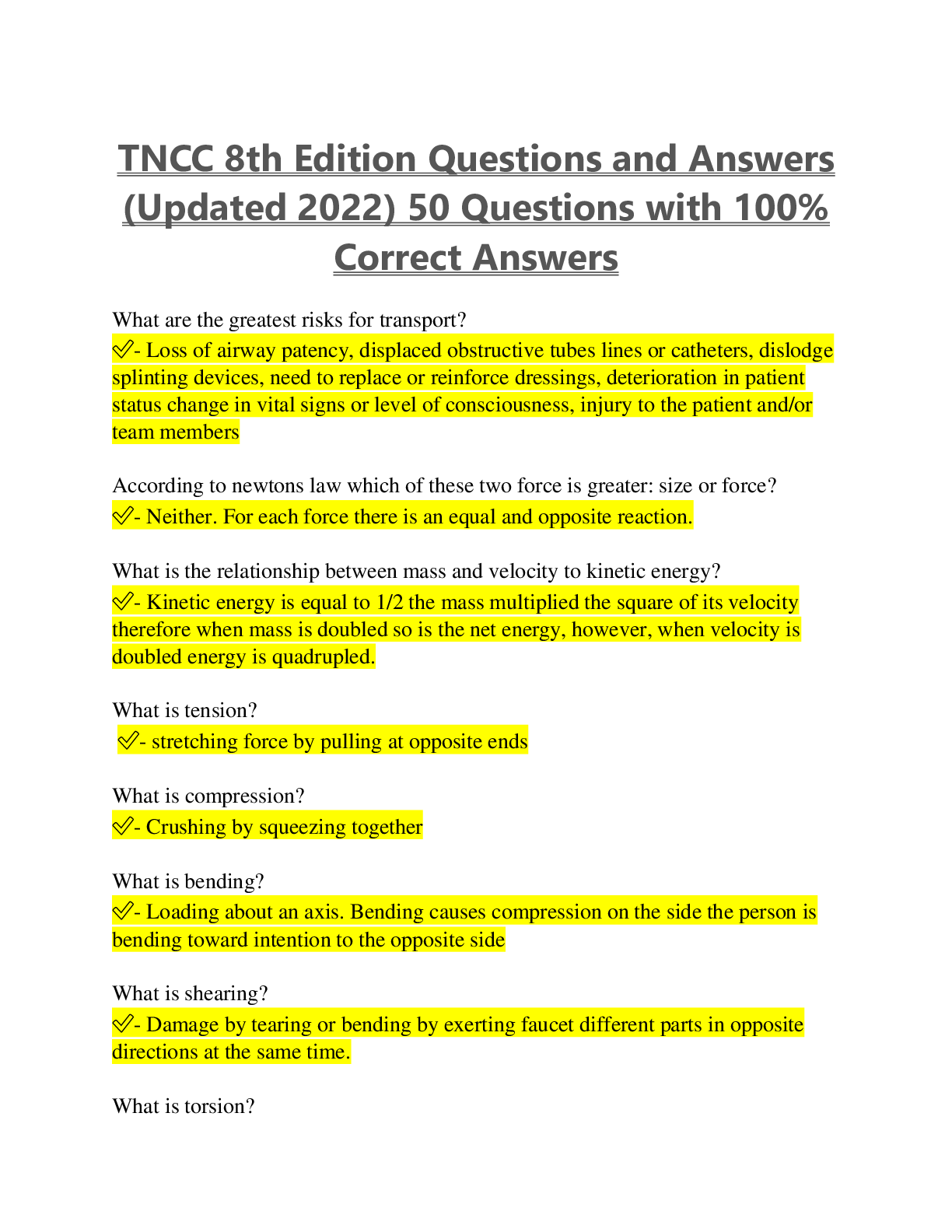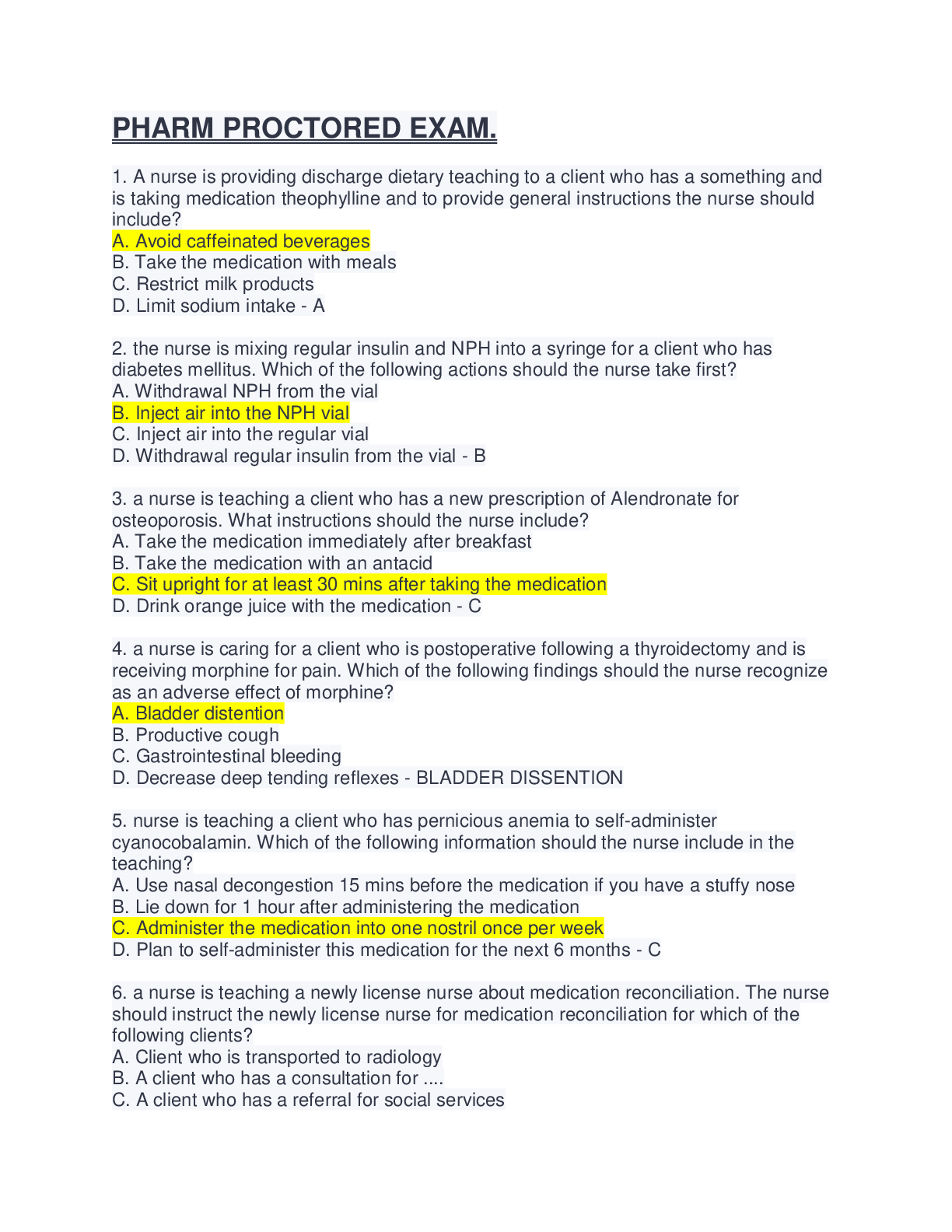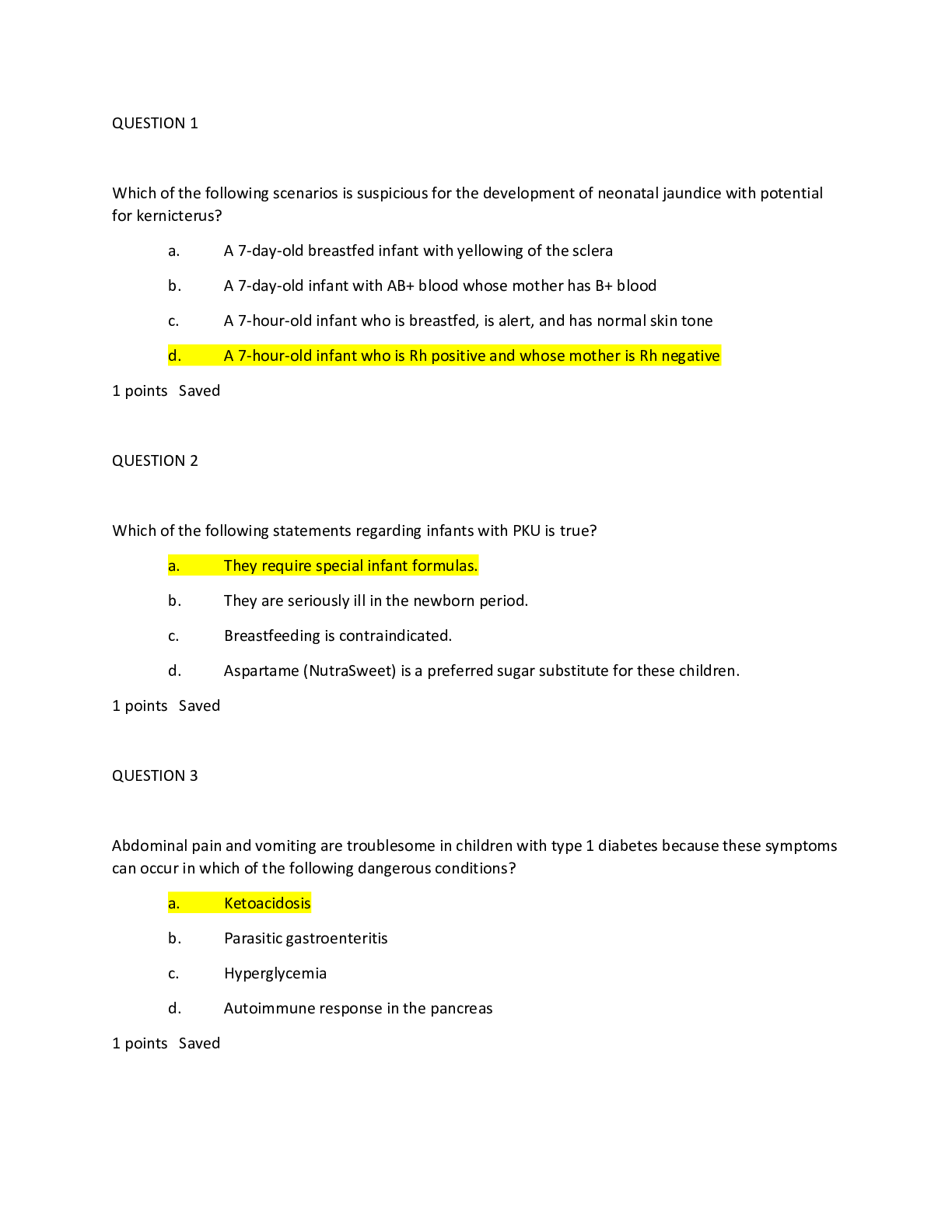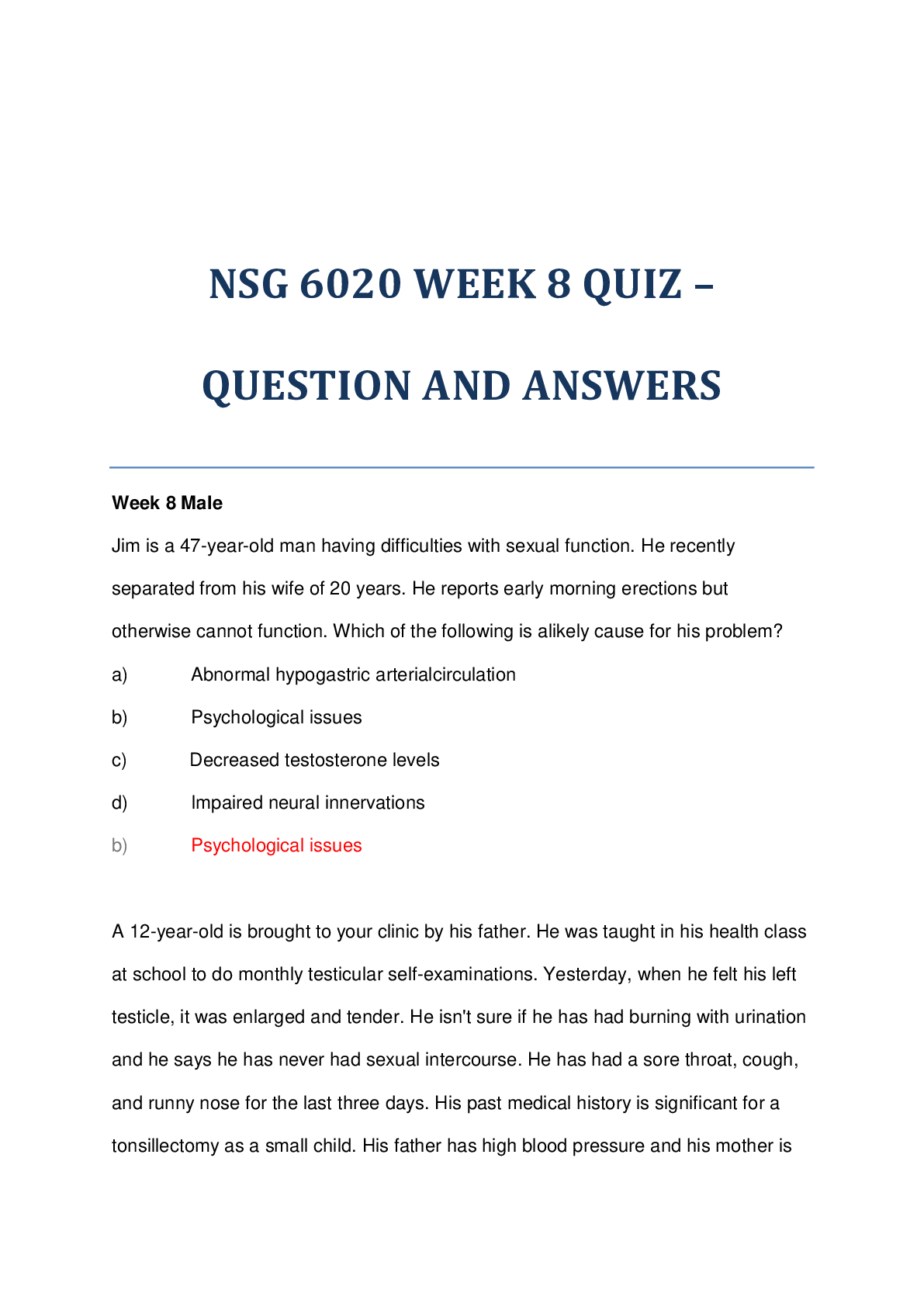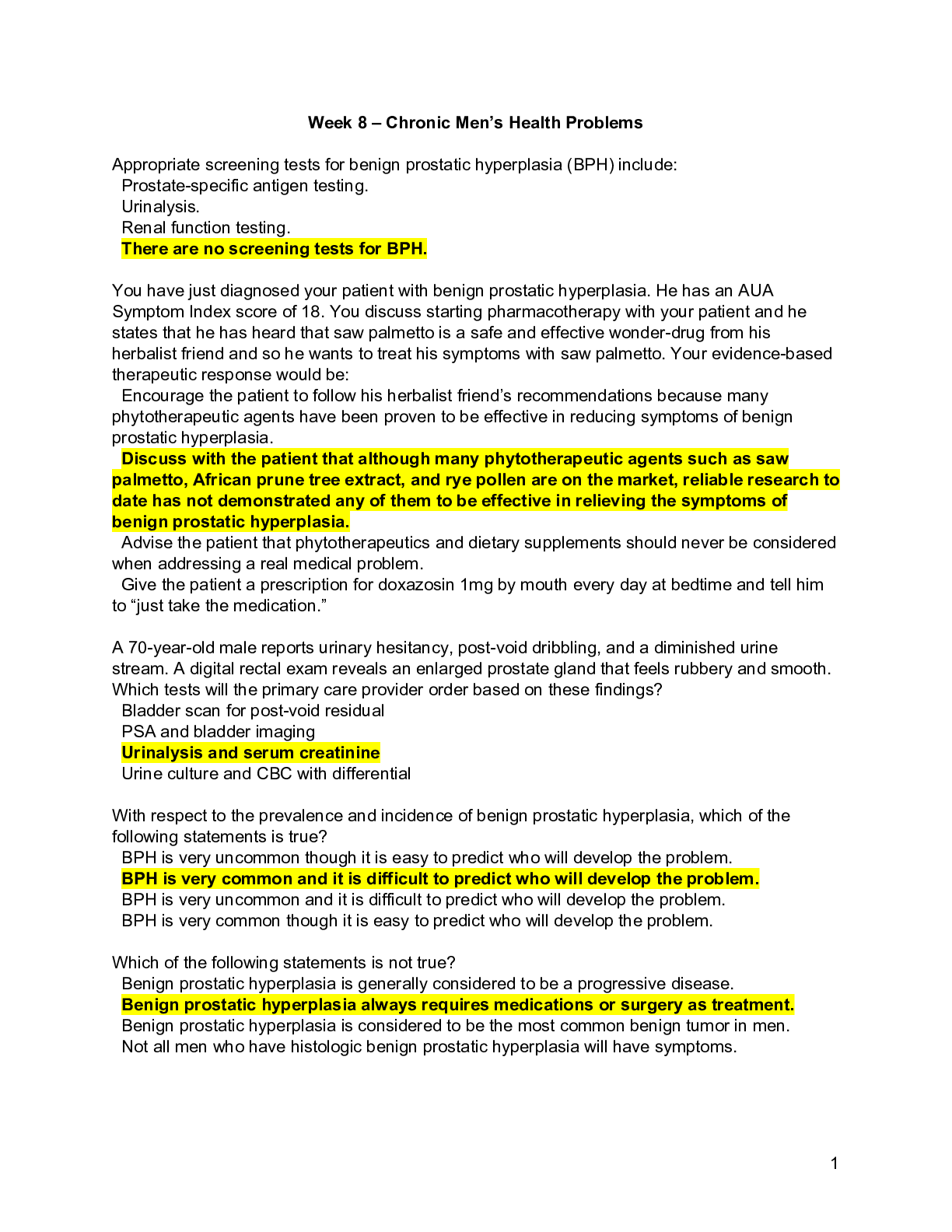*NURSING > QUESTIONS & ANSWERS > NSG 6020 Week 8 Quiz 1 - Question and Answers (2020) complete solution. (All)
NSG 6020 Week 8 Quiz 1 - Question and Answers (2020) complete solution.
Document Content and Description Below
NSG 6020 Week 8 Quiz 1 - Question and Answers A 14-year-old junior high school student is brought in by his mother and father because he seems to be developing breasts. The mother is upset because sh... e read on the Internet that smoking marijuana leads to breast enlargement in males. The young man adamantly denies using any tobacco, alcohol, or drugs. He has recently noticed changes in his penis, testicles, and pubic hair pattern. Otherwise, his past medical history is unremarkable. His parents are both in good health. He has two older brothers who never had this problem. On examination you see a mildly overweight teenager with enlarged breast tissue that is slightly tender on both sides. Otherwise his examination is normal. He is agreeable to taking a drug test. What is the most likely cause of his gynecomastia? A 30-year-old man notices a firm, 2-cm mass under his areola. He has no other symptoms and no diagnosis of breast cancer in his first-degree relatives. What is the most likely diagnosis? A 28-year-old musician comes to your clinic, complaining of a "spot" on his penis. He states his partner noticed it 2 days ago and it hasn't gone away. He says it doesn't hurt. He has had no burning with urination and no pain during intercourse. He has had several partners in the last year and uses condoms occasionally. His past medical history consists of nongonococcal urethritis from Chlamydia and prostatitis. His vital signs are unremarkable. On visualization of his penis there is a 6-mm red, oval ulcer with an indurated base just proximal to the corona. On palpation the ulcer is nontender. In the inguinal region there is nontender lymphadenopathy. What disorder of the penis is most likely the diagnosis? A 20-year-old part-time college student comes to your clinic, complaining of growths on his penile shaft. They have been there for about 6 weeks and haven't gone away. In fact, he thinks there may be more now. He denies any pain with intercourse or urination. He has had three former partners and has been with his current girlfriend for 6 months. He says that because she is on the pill they don't use condoms. He denies any fever, weight loss, or night sweats. He is engaged to be married and has no children. On visualization of his penis you see several moist papules along all sides of his penile shaft and even two on the corona. He has been circumcised. On palpation of his inguinal region there is no inguinal lymphadenopathy. Which abnormality of the penis does this patient most likely have? A 29-year-old married computer programmer comes to your clinic, complaining of "something strange" going on in his scrotum. Last month while he was doing his testicular self-examination he felt a lump in his left testis. He waited a month and felt the area again, but the lump was still there. He has had some aching in his left testis but denies any pain with urination or sexual intercourse. He denies any fever, malaise, or night sweats. His past medical history consists of groin surgery when he was a baby and a tonsillectomy as a teenager. His parents are both healthy. On visualization the penis is circumcised with no lesions; there is a scar in his right inguinal region. There is no lymphadenopathy. Palpation of his scrotum is unremarkable on the right but indicates a large mass on the left. Placing a finger through the inguinal ring on the right, you have the patient bear down. Nothing is felt. You attempt to place your finger through the left inguinal ring but cannot get above the mass. On rectal examination his prostate is unremarkable. What disorder of the testes is most likely the diagnosis? A 32-year-old white male comes to your clinic, complaining of aching on the right side of his testicle. He has felt this aching for several months. He states that as the day progresses the aching increases, but when he wakes up in the morning he is pain-free. He denies any pain with urination and states that the pain doesn't change with sexual activity. He denies any fatigue, weight gain, weight loss, fever, or night sweats. His past medical history is unremarkable. He is a married hospital administrator with two children. He notes that he and his wife have been trying to have another baby this year but have so far been unsuccessful despite frequent intercourse. He denies using tobacco, alcohol, or illegal drugs. His father has high blood pressure but his mother is healthy. On examination you see a young man appearing his stated age with unremarkable vital signs. On visualization of his penis, he is circumcised with no lesions. He has no scars along his inguinal area, and palpation of the area shows no lymphadenopathy. On palpation of his scrotum you feel testes with no discrete masses. Upon placing your finger through the right inguinal ring you feel what seems like a bunch of spaghetti. Asking him to bear down, you feel no bulges. The left inguinal ring is unremarkable, with no bulges on bearing down. His prostate examination is unremarkable. What abnormality of the scrotum does he most likely have? A 48-year-old policeman comes to your clinic, complaining of a swollen scrotum. He states it began a couple of weeks ago and has steadily worsened. He says the longer he stands up the worse it gets, but when he lies down it improves. He denies any pain with urination. Because he is impotent he doesn't know if intercourse would hurt. He states he has become more tired lately and has also gained 10 pounds in the last month. He denies any fever or weight loss. He has had some shortness of breath with exertion. His past medical history consists of type 2 diabetes for 20 years, high blood pressure, and coronary artery disease. He is on insulin, three high blood pressure pills, and a water pill. He has had his gallbladder removed. He is married and has five children. He is currently on disability because of his health problems. Both of his parents died of complications of diabetes. On examination you see a pleasant male appearing chronically ill. He is afebrile but his blood pressure is 160/100 and his pulse is 90. His head, eyes, ears, nose, throat, and neck examinations are normal. There are some crackles in the bases of each lung. During his cardiac examination there is an extra heart sound. Visualization of his penis shows an uncircumcised prepuce but no lesions or masses. Palpation of his scrotum shows generalized swelling, with no discrete masses. A gloved finger is placed through each inguinal ring, and with bearing down there are no bulges. The prostate is smooth and nontender. What abnormality of the scrotum is most likely the diagnosis? A 36-year-old security officer comes to your clinic, complaining of a painless mass in his scrotum. He found it 3 days ago during a testicular self-examination. He has had no burning with urination and no pain during sexual intercourse. He denies any weight loss, weight gain, fever, or night sweats. His past medical history is notable for high blood pressure. He is married and has three healthy children. He denies using illegal drugs, smokes two to three cigars a week, and drinks six to eight alcoholic beverages per week. His mother is in good health and his father had high blood pressure and coronary artery disease. On physical examination he appears anxious but in no pain. His vital signs are unremarkable. On visualization of his penis, he is circumcised and has no lesions. His inguinal region has no lymphadenopathy. Palpation of his scrotum shows a soft cystic-like lesion measuring 2 cm over his right testicle. There is no difficulty getting a gloved finger through either inguinal ring. With weight bearing there are no bulges. His prostate examination is unremarkable. What disorder of the scrotum does he most likely have? A 22-year-old unemployed roofer presents to your clinic, complaining of pain in his testicle and penis. He states the pain began last night and has steadily become worse. He states it hurts when he urinates and he has not attempted intercourse since the pain began. He has tried Tylenol and ibuprofen without improvement. He denies any fever or night sweats. His past medical history is unremarkable. He has had four previous sexual partners and has had a new partner for the last month. She is on oral contraceptives so he has not used condoms. His parents are both in good health. On examination you see a young man lying on his side. He appears mildly ill. His temperature is 100.2 and his blood pressure, respirations, and pulse are normal. On visualization of the penis he is circumcised, with no lesions or discharge from the meatus. Visualization of the scrotal skin appears unremarkable. Palpation of the testes shows severe tenderness at the superior pole of the normal-sized left testicle. He also has tenderness when you palpate the structures superior to the testicle through the scrotal wall. The right testicle is unremarkable. An examining finger is placed through each inguinal ring without bulges being noted with bearing down. His prostate examination is unremarkable. Urine analysis shows white blood cells and bacteria. A 15-year-old high school football player is brought to your office by his mother. He is complaining of severe testicular pain since exactly 8:00 this morning. He denies any sexual activity and states that he hurts so bad he can't even urinate. He is nauseated and is throwing up. He denies any recent illness or fever. His past medical history is unremarkable. He denies any tobacco, alcohol, or drug use. His parents are both in good health. On examination you see a young teenager lying on the bed with an emesis basin. He is very uncomfortable and keeps shifting his position. His blood pressure is 150/100, his pulse is 110, and his respirations are 24. On visualization of the penis he is circumcised and there are no lesions and no discharge from the meatus. His scrotal skin is tense and red. Palpation of the left testicle causes severe pain and the patient begins to cry. His prostate examination is unremarkable. His cremasteric reflex is absent on the left but is normal on the right. By catheter you get a urine sample and the analysis is unremarkable. You send the boy with his mother to the emergency room for further workup. What is the most likely diagnosis for this young man's symptoms? A 16-year-old high school junior is brought to your clinic by his father. The teenager was taught in his health class at school to do monthly testicular self-examinations. Yesterday when he felt his left testicle it was enlarged and tender. He isn't sure if he has had burning with urination and he says he has never had sexual intercourse. He has had a sore throat, cough, and runny nose for the last 3 days. His past medical history is significant for a tonsillectomy as a small child. His father has high blood pressure and his mother is healthy. On examination you see a teenager in no acute distress. His temperature is 100.8 and his blood pressure and pulse are unremarkable. On visualization of his penis, he is uncircumcised and has no lesions or discharge. His scrotum is red and tense on the left and normal appearing on the right. Palpating his left testicle reveals a mildly sore swollen testicle. The right testicle is unremarkable. An examining finger is put through both inguinal rings, and there are no bulges with bearing down. His prostate examination is unremarkable. Urine analysis is also unremarkable. What abnormality of the testes does this teenager most likely have? A 45-year-old electrical engineer presents to your clinic, complaining of spots on his scrotum. He first noticed the spots several months ago, and they have gotten bigger. He denies any pain with urination or with sexual intercourse. He has had no fever, night sweats, weight gain, or weight loss. His past medical history consists of a vasectomy 10 years ago and mild obesity. He is on medication for hyperlipidemia. He denies any tobacco or illegal drug use and drinks alcohol socially. His mother has Alzheimer's disease and his father died of leukemia. On examination he appears relaxed and has unremarkable vital signs. On visualization of his penis, he is circumcised and has no lesions on his penis. Visualization of his scrotum shows three yellow nodules 2-3 millimeters in diameter. During palpation they are firm and nontender. What abnormality of the male genitalia is this most likely to be? Jim is a 47-year-old man who is having difficulties with sexual function. He is recently separated from his wife of 20 years. He notes that he has early morning erections but otherwise cannot function. Which of the following is a likely cause for his problem? Induration along the ventral surface of the penis suggests which of the following? A tender, painful swelling of the scrotum should suggest which of the following? A young man feels something in his scrotum and comes to you for clarification. On your examination, you note what feels like a "bag of worms" in the left scrotum, superior to the testicles. Which of the following is most likely? Which of the following would lead you to suspect a hydrocele versus other causes of scrotal swelling? You are examining a newborn and note that the right testicle is not in the scrotum. What should you do next? Francis is a middle-aged man who noted right-sided lower abdominal pain after straining with yard work. Which of the following would make a hernia more likely? Frank is a 24-year-old man who presents with multiple burning erosions on the shaft of his penis and some tender inguinal adenopathy. Which of the following is most likely? A 22-year-old architecture major comes to your office, complaining of severe burning with urination, a fever of 101 degrees, and aching all over. She denies any upper respiratory, gastrointestinal, cardiac, or pulmonary symptoms. Her past medical history consists of severe acne. She is currently on an oral contraceptive. She has had no pregnancies or surgeries. She reports one new partner within the last month. On examination you see a young woman appearing slightly ill. Her temperature is 100.3 and her pulse and blood pressure are unremarkable. Her head, ears, eyes, nose, throat, cardiac, pulmonary, and abdominal examinations are unremarkable. Palpation of the inguinal nodes shows lymphadenopathy bilaterally. On visualization of the perineum there are more than 10 shallow ulcers along each side of the vulva. Speculum and bimanual examination are unremarkable for findings, although she is very tender at the introitus. Urine analysis has some white blood cells but no red blood cells or bacteria. Her urine pregnancy test is negative. Which disorder of the vulva is most likely in this case? A 60-year-old coach comes to your clinic, complaining of difficulty starting to urinate for the last several months. He believes the problem is steadily getting worse. When asked he says he has a very weak stream and it feels like it takes 10 minutes to empty his bladder. He also has the urge to go to the bathroom more often than he used to. He denies any blood or sediment in his urine and any pain with urination. He has had no fever, weight gain, weight loss, or night sweats. His medical history includes type 2 diabetes and high blood pressure treated with medications. He does not smoke but drinks a six pack of beer weekly. He has been married for 35 years. His mother died of a myocardial infarction in her 70s and his father is currently in his 80s with high blood pressure and arthritis. On examination you see a mildly obese male who is alert and cooperative. His blood pressure is 130/70 with a heart rate of 80. He is afebrile and his cardiac, lung, and abdominal examinations are normal. On visualization of the anus you see no inflammation, masses, or fissures. Digital rectal examination reveals a smooth, enlarged prostate. No discrete masses are felt. There is no blood on the glove or on guaiac testing. An analysis of the urine shows no red blood cells, white blood cells, or bacteria. What disorder of the anus, rectum, or prostate is this most likely to be? A 24-year-old graduate student comes to your clinic, complaining of burning during urination and increased urinary frequency. He has had a low-grade fever (100.5 degrees) and does not feel very well. He is very worried about sexually transmitted diseases because he had a drunken encounter 2 weeks ago and did not use a condom. He has had no recent weight loss, weight gain, or night sweats. His past medical history includes knee surgery in high school and genital warts in college. He does not smoke but drinks six beers every Friday and Saturday night. He denies using any IV drugs but has tried marijuana in the past. His father has high cholesterol but his mother is healthy. On examination he appears tired. His temperature is 99.5 degrees and his blood pressure is 110/70. His abdominal examination is normal. Visualization of the anus shows no masses, inflammation, or fissures. Digital rectal examination reveals a warm, boggy, tender prostate. No discrete masses are felt and there is no blood on the glove. The scrotum and penis appear normal. Urinalysis shows moderate amounts of white blood cells and bacteria. What disorder of the anus, prostate, or rectum best describes this situation? A 45-year-old African-American minister comes to your clinic for a general physical examination. He has not been feeling very well for about 3 months, including night sweats and a chronic low-grade fever of 100 to 101 degrees. He denies any upper respiratory symptoms, chest pain, nausea, constipation, diarrhea, blood in his stool, or urinary tract symptoms. He has had some lower back pain. He has a past history of difficult-to-control high blood pressure and high cholesterol. He has had no surgeries in the past. His mother has diabetes and high blood pressure. He knows very little about his father because his parents divorced when he was young. He knows his father died in his 50s, but he is unsure of the exact cause. The patient denies smoking, drinking, or drug use. He is married and has three children. On examination he appears his stated age and is generally fit. His temperature is 99.9 degrees and his blood pressure is 160/90. His head, ears, nose, throat, and neck examinations are normal. His cardiac, lung, and abdominal examinations are also normal. On visualization of the anus there is no inflammation, masses, or fissures. Digital rectal examination elicits an irregular, asymmetric, hard nodule on the otherwise normal posterior surface of the prostate. Examination of the scrotum and penis are normal. Laboratory results are pending. What disorder of the anus, rectum, or prostate is mostly likely in this case? Which is a sign of benign prostatic hyperplasia? Which is true of prostate cancer? Mr. Jackson is a 50-year-old African-American who has had discomfort between his scrotum and anus. He also has had some fevers and dysuria. Your rectal examination is halted by tenderness anteriorly, but no frank mass is palpable. What is your most likely diagnosis? [Show More]
Last updated: 1 year ago
Preview 1 out of 7 pages
Instant download

Buy this document to get the full access instantly
Instant Download Access after purchase
Add to cartInstant download
Reviews( 0 )
Document information
Connected school, study & course
About the document
Uploaded On
Oct 23, 2020
Number of pages
7
Written in
Additional information
This document has been written for:
Uploaded
Oct 23, 2020
Downloads
0
Views
74

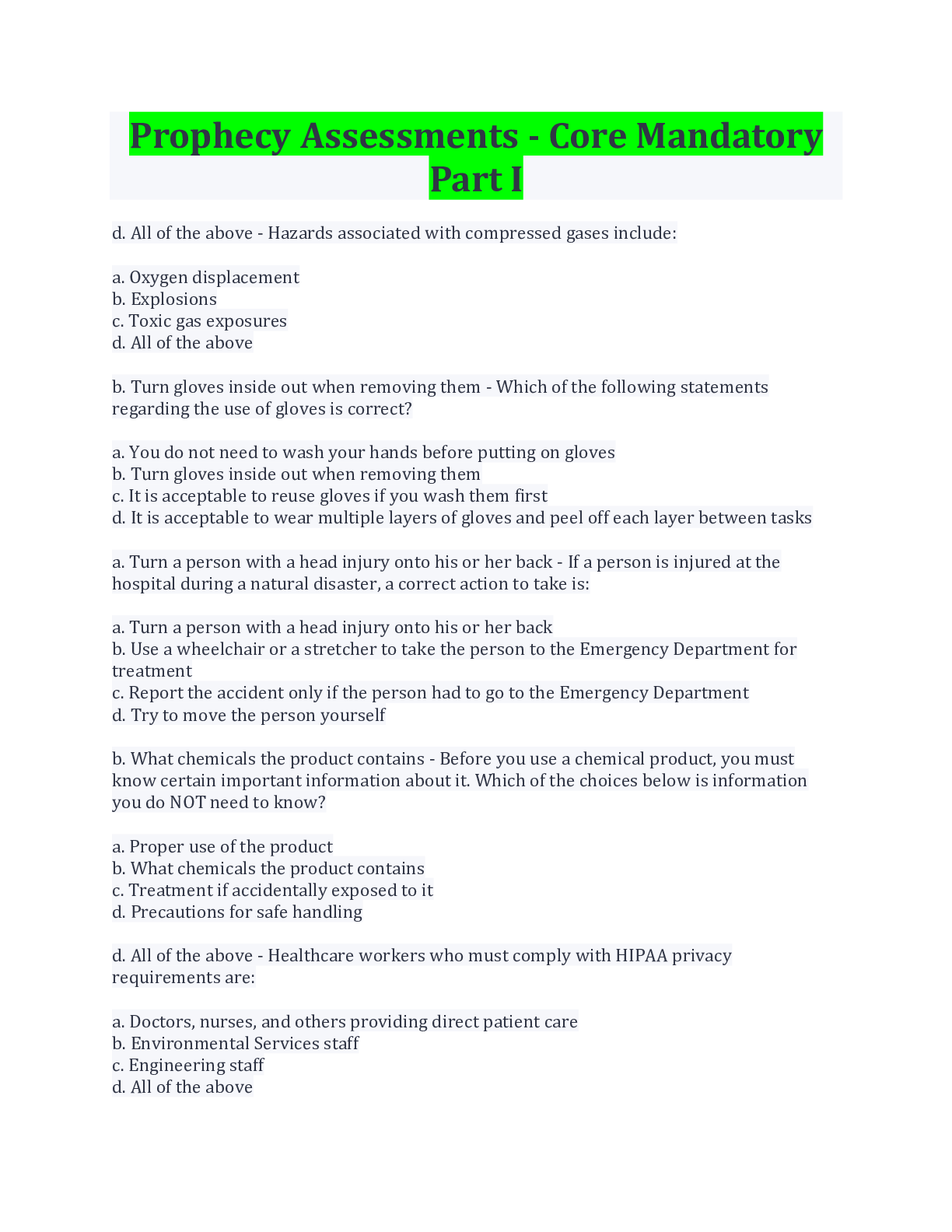
.png)
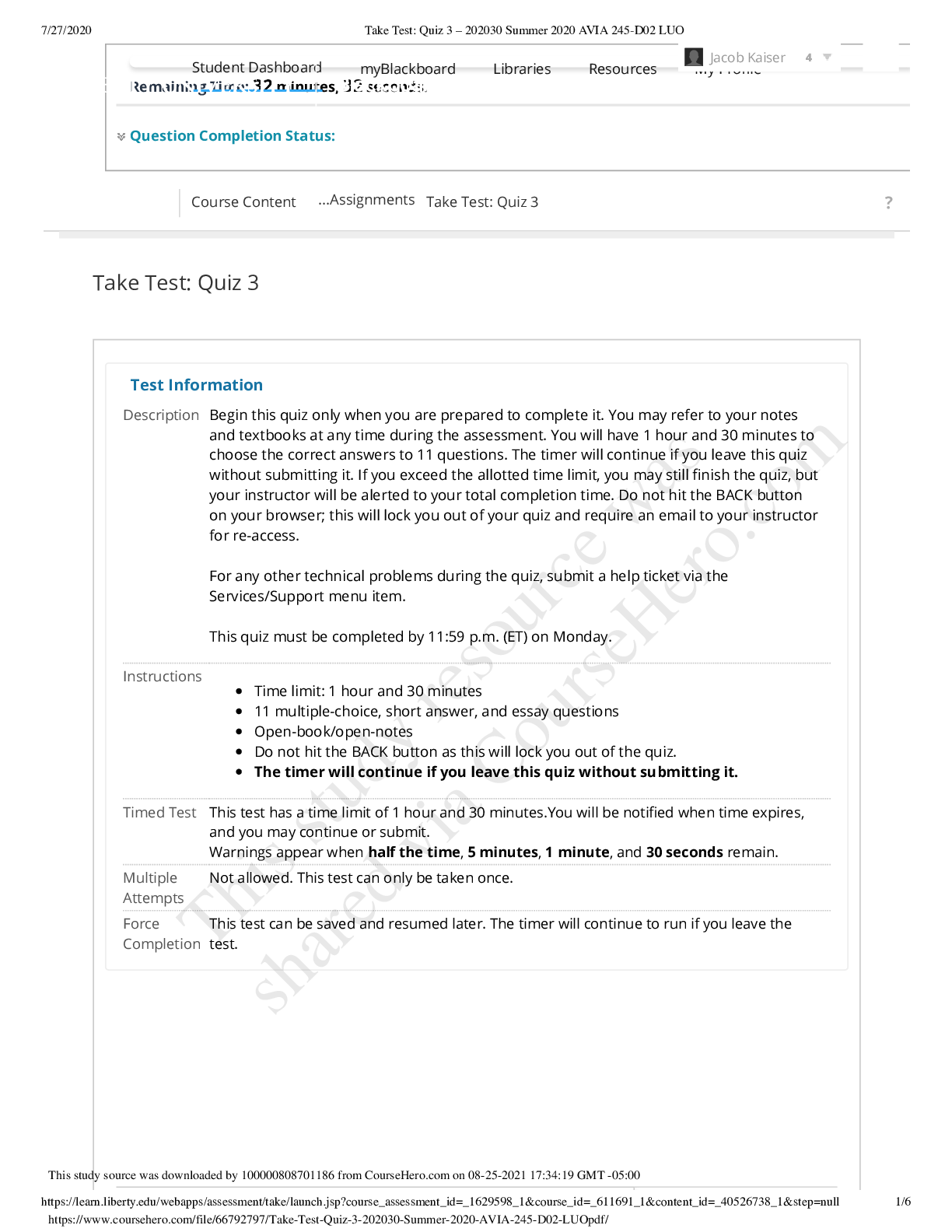
.png)

